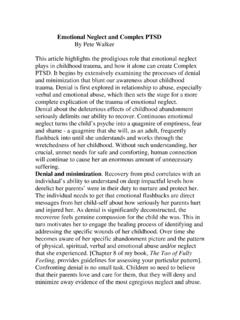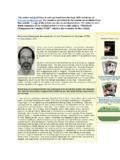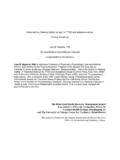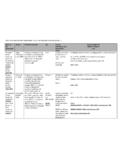Transcription of PTSD and Cognitive Processing Therapy Presented by ...
1 ptsd and Cognitive Processing Therapy Presented by Patricia A. Resick, PhD, ABPP. 2016 ABPP Annual Conference & Workshops Chicago, IL. Saturday, May 14, 2016. Exposure to actual or threatened a) death, b) serious injury, or c) sexual violation, in one or Presence of one or more of the following intrusion more of the following ways: symptoms associated with the traumatic event(s), 1. Directly experiencing the traumatic event(s) beginning after the traumatic event(s) occurred: 2. Witnessing, in person, the traumatic event(s) as they 1. Spontaneous or cued recurrent, involuntary, and occurred to others intrusive distressing memories of the traumatic event(s). 3. Learning that the traumatic event(s) occurred to a close 2. Recurrent distressing dreams in which the content or family member or close friend; cases of actual or threatened death must have been violent or accidental affect of the dream is related to the event(s) 4. Experiencing repeated or extreme exposure to aversive 3.
2 Dissociative reactions ( , flashbacks) in which the details of the traumatic event(s) ( , first responders individual feels or acts as if the traumatic event(s) are collecting human remains; police officers repeatedly exposed recurring (such reactions may occur on a continuum, with to details of child abuse); this does not apply to exposure through electronic media, television, movies, or pictures, the most extreme expression being a complete loss of unless this exposure is work related. awareness of present surroundings. Presence of one or more of the following intrusion symptoms associated with the C. Persistent avoidance of stimuli associated with the traumatic event(s), beginning after the traumatic traumatic event(s), beginning after the traumatic event(s) occurred: event(s) occurred, as evidenced by avoidance or efforts 4. Intense or prolonged psychological distress at exposure to avoid one or more of the following: to internal or external cues that symbolize or resemble an 1.)
3 Distressing memories, thoughts, or feelings about or aspect of the traumatic event(s) closely associated with the traumatic event(s). 5. Marked physiological reactions to reminders of the 2. External reminders ( , people, places, traumatic event(s) conversations, activities, objects, situations) that arouse distressing memories, thoughts, or feelings about, or that are closely associated with, the traumatic event(s). Negative alterations in cognitions and mood Negative alterations in cognitions and mood associated with the traumatic event(s), beginning or worsening after the traumatic event(s) occurred), as associated with the traumatic event(s), beginning or evidenced by two or more of the following: worsening after the traumatic event(s) occurred), as 1. Inability to remember an important aspect of the evidenced by two or more of the following: traumatic event(s) (typically due to dissociative amnesia that is not due to head injury, alcohol, or drugs). 4. Persistent negative emotional state ( , fear, horror, 2.
4 Persistent and exaggerated negative beliefs or anger, guilt, or shame). expectations about oneself, others, or the world ( , I am 5. Markedly diminished interest or participation in bad, No one can be trusted, "The world is completely dangerous"). (Alternatively, this might be expressed as, , significant activities. I've lost my soul forever, or My whole nervous system is 6. Feelings of detachment or estrangement from others. permanently ruined ). 3. Persistent, distorted blame of self or others about the 7. Persistent inability to experience positive emotions cause or consequences of the traumatic event(s). ( , unable to have loving feelings, psychic numbing). Marked alterations in arousal and reactivity associated F. Duration of the disturbance (Criteria B, C, D, and with the traumatic event(s), beginning or worsening E) is more than 1 month. after the traumatic event(s) occurred, as evidenced by G. The disturbance causes clinically significant two or more of the following: distress or impairment in social, occupational, or 1.
5 Irritable or aggressive behavior other important areas of functioning. 2. Reckless or self destructive behavior 3. Hypervigilance H. The disturbance is not attributed to the direct physiological effects of a substance ( , 4. Exaggerated startle response medication, drugs, or alcohol) or another medical 5. Problems with concentration condition ( traumatic brain injury). 6. Sleep disturbance ( , difficulty falling or staying asleep or restless sleep). Subtype: Posttraumatic Stress Disorder With Prominent Dissociative (Depersonalization/Derealization) Symptoms individual meets the diagnostic criteria for ptsd and in addition experiences persistent or recurrent symptoms of A1, A2, or both: A1. Depersonalization: Experiences of feeling detached from, and as if A Functional Model one is an outside observer of, one's mental processes or body ( , feeling as though one is in a dream, sense of unreality of self or body, or time moving slowly. of A2. Derealization: Experiences of unreality of one's surroundings ( , world around the person is experienced as unreal, dreamlike, distant, or distorted).)
6 Posttraumatic Stress B. The disturbance is not due to the direct physiological effects of a substance ( , blackouts, or behavior during Disorder alcohol intoxication), or another medical condition ( , complex partial seizures). If the event is severe enough, nearly everyone will have symptoms reflective of ptsd . Let's start with the most homogeneous severe event: rape 2 12 2 12. = Resick et al. = Riggs et al. 30. ptsd . 25 Non- ptsd . 20. ptsd Severit y Score 15. Let's rearrange and think 10. about post trauma 5. symptoms a bit differently 0 Weeks 1 2 3 4 5 6 7 8 9 10 11 12. Rothbaum, , Foa, , Riggs, , Murdock, T. & Walsh, W. (1992). A prospective examination of posttraumatic stress disorder in rape victims. Journal of Traumatic Stress, 5, 455-475. Emotions Cognitions Persistent negative Guilt/self-blame Erroneous other Emotions Lack of positive emotions E blame Detachment from others V Intrusions Negative beliefs E about future, self, E Flashbacks V. others Cognitions and amnesia N E Emotions T N.
7 T Intrusions irritable or aggressive behavior reckless or self destructive behavior problems with concentration sleep disturbance Intrusions E Emotions/. V Intrusions Cogntions E Arousal Arousal/Reactivity reactivity N. T Cognitions When intrusions occur, natural emotions and arousal run their course and thoughts have a chance to be examined and corrected. It is an active approach process of dealing with the event. This list is not exhaustive Any behavior that serves to Intrusions escape/avoid reactivity Cognitions/ /Arousal reminders, negative emotions trauma related emotions, images or thoughts is functioning as Avoidance of avoidance Core Reactions external reminders and And internal reminders Intrusions Arousal/. Cognitions reactivity Intrusions emotions Arousal/. Cognitions, reactivit emotions y Core Reactions Core Reactions Escape/Avoidance Escape/Avoidance Well modulated emergency response PFC. Can change in Amygdala Amygdala ptsd symptoms be top down as well as bottom Brain stem up?
8 Threat (UCS). Resick and Rasmusson, 2010. ptsd Response Bremner et al 1999b; Milad, PFC et al. 2009; Rauch et al 1998, 2000; Shin, et al. 2001. Amygdala What is the role of Can we find cognition? another route to Brain stem change? Trauma Triggers (CS). Resick and Rasmusson, 2010. A. Match B. Label Angry Afraid C. Shapes Hariri, Bookheimer & John C. Mazziotta (1999). How Cognitive Therapy May Work PFC. match label BL Amygdala CE. Brain stem CT forces the frontal lobe on line which Trauma focused inhibits the amygdala and prevents Cognitive Therapy extreme emotional responses, even while the trauma circuit is simultaneously & sufficiently activated. Resick and Rasmusson, 2010. Throughout their lives, people are taking in information through all of their senses. These beliefs work as long as there is no contradictory information. We work to organize all of that information (words, categories, schemas, etc.) in an attempt to understand, predict and control. Traumas that lead to ptsd are schema (belief) incongruent with prior positive beliefs and/or schema Most people are taught the just world belief by parents, congruent with previous negative beliefs.
9 Teachers, religions, culture. Intrusive symptoms occur as a result of the inability to We tend to believe that good behavior is rewarded and accommodate the information . mistakes or bad behavior are punished. Once the trauma is over, it is a memory. It is important information that has to be integrated.. People have three possibilities: Beliefs Trauma The information matches and is incorporated. They change their view of the world/themselves to incorporate the new information. They change too much and interpret everything in light of this new information. It is a just I must have done world People can be something bad to I am a bad People cannot trusted deserve this person be trusted I deserved it I knew I. Beliefs . STUCK. Trauma It is my fault Beliefs . STUCK. Trauma shouldn't have trusted him/her I could have I have no control See, I have no I am in control prevented this over anything control I can get Bad things close to Good people happen to good I can't get do bad things others people close to anyone Betrayal RECOVERY Betrayal Beliefs.
10 STUCK. Trauma Beliefs Trauma I have power over The world is many things, but not A different action The world is safe all things might have had a bad completely unsafe outcome The therapist needs There are two types to determine which of emotions Over kind of emotion it is Assimilation Natural emotions emanate accommodation directly from the event and are If natural, clients need to (about the hard wired (about present and feel and let it run its past/trauma) fight flight response fear . future) anger course. Natural emotions dissipate quickly Losses sadness Disgust withdrawal Manufactured emotions are produced by thoughts and If manufactured, clients Undoing, ( if only, should have ) Conclusions, implications of trauma beliefs need to change their guilt or blame about trauma ( never, always, no one , all re: 5 themes) Self blame thoughts guilt thinking. Other blame thoughts anger or rage Challenging avoidance. Substance abuse/dependence Self harm/suicidality/homicidality Dissipation of natural emotions.




